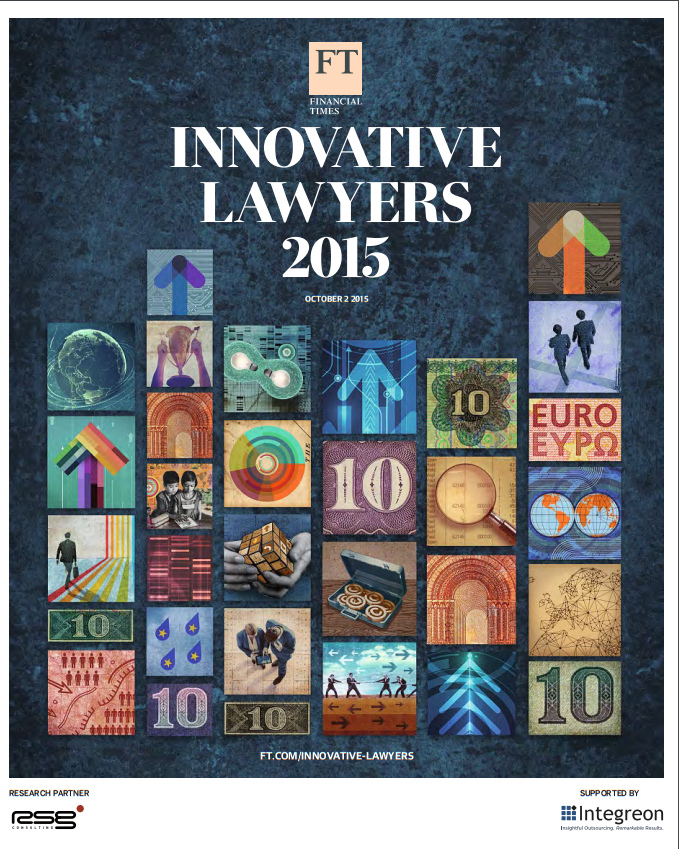The 2015 edition of the Innovative Lawyers report, produced by the Financial Times (FT), chronicles a fascinating range of recent developments and innovations within the legal profession in Europe while weighing and ranking the work of European legal organizations. The FT special report reveals that in many ways the legal profession is changing, innovating, and competing.

Reena SenGupta, the founder of RSG Consulting, the FT’s research partner in the report, writes in an opening article that a decade ago, “law firms were enjoying double-digit growth and there was a feeling the bumper years would never end. … Skip forward to 2015 and there is a new mentality in the European legal profession. … Today, nearly all of the top 20 U.K.-originated law firms have a low-cost delivery center. … Innovation is now a value to which law firms and in-house aspire, but some lawyers still equate it to providing services more cheaply.”
In some ways the global economic crisis was a cautionary tale that compelled companies and firms to exercise greater restraint and adopt change more slowly, but in other ways it created an environment that encouraged companies and firms to take on more risk by putting immense pressure on them to do more with less. In the aftermath of the crisis, lawyers “were called on to steady business and governments.” In the aftermath of the aftermath, and in response to more-stringent post-crisis regulations, corporations are looking to lawyers for help and law firms are coming up with new and different ways to serve their clients’ interests.
For instance, in “Diverse Models,” an article on the growing diversity in the profession, Jane Croft notes, “While some firms are taking on the accountancy giants, other are finding more unorthodox ways to boost their bottom line.” On the one hand, and illustrative of what she refers to as the “march of the accountants,” Ernst & Young has hired partners from law firms like Freshfields and Addleshaw Goddard to their practices. Indeed, PricewaterhouseCoopers, which FT named the third most innovative law firm in continental Europe, has committed to building up its legal services division (see “The Reemergence of the Big Four in Law”).
On the other hand, law firms are not going silently into the night. Indeed, law firms are fighting back by hiring accountants and bolstering their expertise in areas traditionally dominated by accountants. (see “Navigating a Brave New World”). Moreover, nonlawyers account for half of the fee earners in Baker & McKenzie’s corporate tax practice. Pinsent Masons’ tax team is composed of both lawyers and accountants. Spain-based law firm Garrigues has hired economists and financial analysts to work alongside the firm’s lawyers.
Firms are also focused on lowering costs and increasing their use of technology. Lindsay Fortado notes in the article “A Full Suite” that “despite the usual slow pace of change in the legal industry, how firms creatively and more efficiently deliver legal work has evolved as they seek competitive advantage.” With its hedge fund and private equity clients facing increased regulation starting in July 2014, Simmons & Simmons, a U.K.-based firm, created the Navigator system, a tool that provides the firm’s asset management clients with access to regularly updated advice on how to comply with fund regulations in more than 90 jurisdictions.
Leading U.K. law firms, including Allen & Overy and Herbert Smith, have opened lower-cost service centers outside of London and have started to use contract lawyers. Similarly, part of Berwin Leighton Paisner’s “integrated client service model” is to use a contract lawyer agency called Lawyers on Demand. And Eversheds recently launched a managed service arm called Eversheds Ignite (see “Navigating a Brave New World”).
Firms are also looking toward technology to take on substantive roles typically performed by lawyers. For instance, in 2014 Baker & McKenzie launched a digital tool called Global Merger Analysis Platform (GMAP), which is designed to identify the antitrust issues for any deal—something that used to take lawyers hours of (billable) time. Similarly, students at the University of Toronto were tasked with finding a useful application for IBM’s Watson, a well-known cognitive technology that has the ability to learn. The students came up with ROSS, a legal research service that provides sophisticated answers to legal questions “by sifting through huge quantities of legal documents, cases, and legislation” and can refine its responses based on experience.
Whether the multitude of changes and innovations highlighted in the FT report truly constitute progress, improvement, or advancement remains uncertain. What is certain is that the legal profession is changing—and all sides of the profession are experimenting with ways to push forward.



